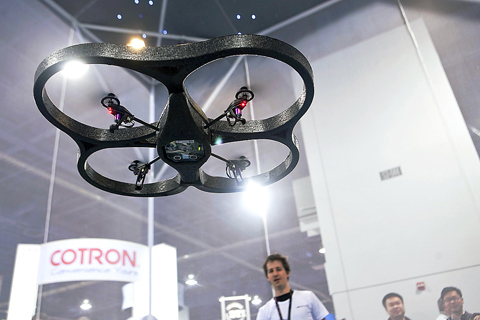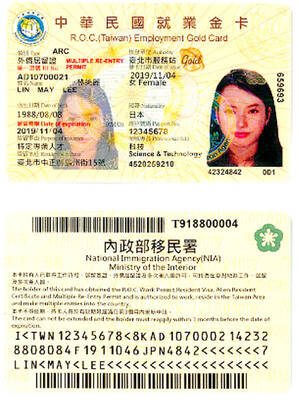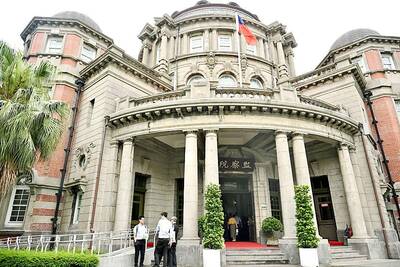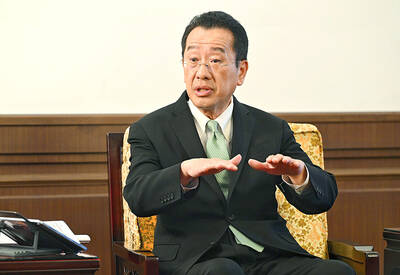The premier Consumer Electronics Show (CES) that ended yesterday rebounded from a global economic drubbing, wowing attendees with gadgets that merge 3D, software, entertainment and the Web.
“CES is back,” analyst Rob Enderle of the Enderle Group said of the annual event at which electronics makers from around the world gather to display their latest creations.
“Last year when I left I was thinking ‘It’s the last CES.’ It was a morgue.”

PHOTO: BLOOMBERG
Device makers who felt the chill the fiscal crisis put on sales of consumer electronics last year poured passion and innovation into proven products and hot trends such at electronic-readers and 3D TV sets.
“This is one of the most exciting CES events we’ve had in years,” said Scott Steinberg, lead technology analyst for DigitalTrends.com.
“There is innovation in terms of incremental gains instead of revolutionary changes. We are seeing baby steps and hints of giant steps to come,” he said.
Two Silicon Valley titans absent from the show floor left giant footprints on the gathering of more than 2,500 exhibitors.
CES was awash in e-reader, tablet and slate devices that in some cases seemed hurried out to get a jump on an “iSlate” that iPhone, iPod and Macintosh computer maker Apple is expected to unveil later this month.
“I think a lot of the tablet buzz was trying to get upwind of Apple,” said Roger Kay, president of Massachusetts-based Endpoint Technologies Associates.
“It’s kind of a game of chicken or leapfrog where you’re investing or pretending to invest in the tablet area in a bid to try to claim it before someone else gets there,” he said.
A host of device makers unveiled smartphones, netbooks, or tablets based on Google’s Android software.
A Google team had the Internet star’s new Nexus One smartphone available for private meetings and on display one evening at an event in a Las Vegas hotel but not on the CES show floor.
“Google was kind of the stealth company here,” Enderle said. “Google Androids were in devices all over the place.”
TV makers who have seen prices driven down by competition and the economy enthralled CES attendees by crafting eye-grabbing 3D and Internet services into high-definition flat-screen models.
“We’ve seen a pretty dramatic shift from hardware-centric to software-centric,” Gartner analyst Van Baker said of TVs unveiled at CES.
“Manufacturers are struggling with that. Increasing the value with software implies service, and it’s not an easy transition for them,” he said.
Internet pioneer Yahoo added its software “widgets” to some TVs last year at CES and built on that momentum this week with an expanded array of sets and online services.
“It won’t be long before every TV is Web-connected in one shape or form, whether it’s technology in the TV or through a set-top box,” Enderle said.
“They’re all pushing this pretty hard,” he said.
Forrester Research analyst James McQuivey said that 3D TVs face “an uphill slog” and it is unlikely consumers will rush to buy them after many upgraded to high-definition sets in the past three years.
“I don’t think we are going to be wearing those 3D glasses at home any time soon,” Steinberg said.
Growth of 3D has been slow because of a lack of programming, the need for the special glasses and the higher prices of 3D sets.
But, last month’s release of science fiction blockbuster Avatar, a 3D film by Titanic director James Cameron, has renewed interest in the medium and ESPN, Discovery and others announced plans this week to broadcast 3D programming.
In another nod to Digital Age tastes, CES abounded with chips, controllers and other offerings tailored to enhance videogame play as far as making experiences 3D.
By yesterday, CES had logged more than 112,000 attendees in a 20 percent jump from last year’s gathering, said Consumer Electronics Association, which runs the event.
Gartner expects consumer electronics sales to improve along with the economy.

GAINING STEAM: The scheme initially failed to gather much attention, with only 188 cards issued in its first year, but gained popularity amid the COVID-19 pandemic Applications for the Employment Gold Card have increased in the past few years, with the card having been issued to a total of 13,191 people from 101 countries since its introduction in 2018, the National Development Council (NDC) said yesterday. Those who have received the card have included celebrities, such as former NBA star Dwight Howard and Australian-South Korean cheerleader Dahye Lee, the NDC said. The four-in-one Employment Gold Card combines a work permit, resident visa, Alien Resident Certificate (ARC) and re-entry permit. It was first introduced in February 2018 through the Act Governing Recruitment and Employment of Foreign Professionals (外國專業人才延攬及雇用法),

WARNING: From Jan. 1 last year to the end of last month, 89 Taiwanese have gone missing or been detained in China, the MAC said, urging people to carefully consider travel to China Lax enforcement had made virtually moot regulations banning civil servants from making unauthorized visits to China, the Control Yuan said yesterday. Several agencies allowed personnel to travel to China after they submitted explanations for the trip written using artificial intelligence or provided no reason at all, the Control Yuan said in a statement, following an investigation headed by Control Yuan member Lin Wen-cheng (林文程). The probe identified 318 civil servants who traveled to China without permission in the past 10 years, but the true number could be close to 1,000, the Control Yuan said. The public employees investigated were not engaged in national

The zero emissions ship Porrima P111 was launched yesterday in Kaohsiung, showcasing the nation’s advancement in green technology, city Mayor Chen Chi-mai (陳其邁) said. The nation last year acquired the Swiss-owned vessel, formerly known as Turanor PlanetSolar, in a bid to boost Taiwan’s technology sector, as well as ecotourism in Palau, Chen said at the ship’s launch ceremony at Singda Harbor. Palauan President Surangel Whipps Jr and Minister of Foreign Affairs Lin Chia-lung (林佳龍) also attended the event. The original vessel was the first solar-powered ship to circumnavigate the globe in a voyage from 2010 to 2012. Taiwan-based Porrima Inc (保利馬) installed upgrades with

ENHANCE DETERRENCE: Taiwan has to display ‘fierce resolve’ to defend itself for China to understand that the costs of war outweigh potential gains, Koo said Taiwan’s armed forces must reach a high level of combat readiness by 2027 to effectively deter a potential Chinese invasion, Minister of National Defense Wellington Koo (顧立雄) said in an interview with the Chinese-language Liberty Times (sister newspaper of the Taipei Times) published yesterday. His comments came three days after US Secretary of State Marco Rubio told the US Senate that deterring a Chinese attack on Taiwan requires making a conflict “cost more than what it’s worth.” Rubio made the remarks in response to a question about US policy on Taiwan’s defense from Republican Senator John Cornyn, who said that Chinese